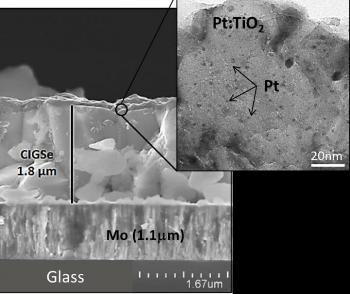May 14 2015
Researchers from the Helmholtz-Zentrum Berlin (HZB) Institute for Solar Fuels have developed an innovative stable photoelectrode that holds promise for artificial photosynthesis. This study has been done under the "Light2Hydrogen" BMBF Cluster project and as part of the "Solar H2" DFG Priority programme.
 A scanning electron microscopy shows a cross section of the composite photocathode (left). By TEM analysis, nanoparticles of Pt could be identified in the TiO2 thin film (right). Credit: HZB
A scanning electron microscopy shows a cross section of the composite photocathode (left). By TEM analysis, nanoparticles of Pt could be identified in the TiO2 thin film (right). Credit: HZB
When two electrodes are held in an aqueous electrolyte and a sufficient voltage is applied, then hydrogen and oxygen gas bubbles are formed. When sunlight in a solar cell is used to generate the voltage then generating hydrogen gas could help store solar energy. Hydrogen has the capability to store and use chemical energy.
A low-cost system that is strong and compact is desirable, and worldwide researchers are trying to develop such a system. However, hydrogen generation takes place efficiently in acidic electrolytes, and as these electrolytes are corrosive, corrosion of solar cells takes place very rapidly. Very expensive elements have been mostly used for electrodes before now.
The new composite photocathode that has been developed uses sunlight to generate hydrogen. This is performed with high quantum efficiency, and allows storage of solar energy chemically. A thin polycrystalline film of photoresistant titanium dioxide (TiO2) that contains a small amount of platinum nanoparticles was used to coat HZB/PVcomB, and this material was used for production of a thin film of chalcopyrite. The composite photocathode is made up of the chalcopyrite film.
This chalcopyrite film is protected from getting corroded by the thin film layer. Furthermore, it accelerates hydrogen formation by functioning as a catalyst. It also demonstrates photoelectric current voltage and density that is similar to that demonstrated by a chalcopyrite-based thin film solar cell.
Under sun light, the new composite has the ability to produce nearly 0.5V photovoltage and upto 38 mA/cm2 photocurrent density. As TiO2 is transparent, nearly all the sunlight reaches the chalcopyrite.
Associate Professor Thomas Schedel-Niedrig headed the research team. Anahita Azarpira developed the formula for this coating as part of her doctoral studies, under Schedel-Niedrig’s team. The HZB Institute for Heterogeneous Material Systems had developed and patented sprayed ion-layer gas reaction (Spray-ILGAR) chemical vapour coating technique. This was used in development of the innovative coating.
An ultrasonic bath is used for converting platinum and titanium dioxide precursors dissolved in ethanol into a fog. A nitrogen gas stream is used to make the resulting aerosol to flow over the heated substrate. Over a period of time, this leads to growth of a polycrystalline thin film on the chalcopyrite substrate containing platinum nanoparticles.
In order to enhance the composite photoelectrode device’s properties, the quantity of platinum was varied. The research team found that the device obtained optimal properties when the volumetric proportion of platinum was approximately 5% of the precursor solution.
More than 80 % of the incident visible sunlight was photoelectrically converted by this composite system into electric current available for the hydrogen generation.
Thomas Schedel-Niedrig, Associate Professor - Helmholtz-Zentrum Berlin Institute for Solar Fuels
The quantum efficiency hence remains very high virtually, and minimal loss of light occurs. Other recent studies report that this composite remains stable over duration of 25 hours and under illumination it demonstrates 690 hydrogen molecules for every second for every active center.
The researchers state that more developments are required. The solar-to-hydrogen efficiency has to be improved as a battery is still used to provide approximately 1.8V of the necessary voltage between a platinum counter electrode and composite photocathode.
"But anyway, we demonstrate the feasibility of such future-oriented chemical robust photoelectrocatalytic systems that have the potential to convert solar energy to hydrogen, i.e to chemical energy for storage. As a consequence we have successfully developed and tested a demonstrator device for solar hydrogen production with a company in Schwerin under the Light2Hydrogen project,” says Schedel-Niedrig.
This study has been published as a paper titled “Efficient and Stable TiO2:Pt–Cu(In,Ga)Se2 Composite Photoelectrodes for Visible Light Driven Hydrogen Evolution” in the Advanced Energy Materials journal.